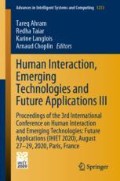Abstract
The Collaborative Communication Interruption Management System or C-CIMS [1] uses machine learning techniques to build task boundary inference models to send interruptions at appropriate times within distributed multi-user, multitasking interactions. The primary objective of this work is to explore improving C-CIMS performance using speaker and team dependent machine learning techniques. This has the potential to optimize system performance for each talker or team engaged in the interaction. An analysis of variance illustrated that there is a significant difference in C-CIMS performance using the talker-dependent models compared to the team-dependent models. Additionally a subset of talker and teams significantly outperform the baseline model. These results motivate the continued exploration of additional techniques to maximize C-CIMS performance in making improved accurate decisions in disseminating interruptions.
Access this chapter
Tax calculation will be finalised at checkout
Purchases are for personal use only
References
Peters, N.: Collaborative Communication Interruption Management System (C-CIMS): modeling interruption timings via prosodic and topic modelling for human-machine teams. Doctoral Dissertation, Carnegie Mellon University, Pittsburgh (2017)
Arroyo, E., Selker, T.: Attention and intention goals can mediate disruption in human-computer interaction. In: IFIP Conference on Human-Computer Interaction, Berlin (2011)
Bailey, B., Konstan, J.A.: On the need for attention-aware systems: Measuring effects of interruption on task performance, error rate, and affective state. Comput. Hum. Behav. 22(4), 685–708 (2006)
Czerwinski, M., Cutrell, E., Horvitz, E.: Instant messaging and interruption: Influence of task type on performance. In: OZCHI Conference Proceedings (2000)
Monk, C., Boehm-David, D., Trafton, G.: The attentional costs of interrupting task performance at various stages. In: Proceedings of the Human Factors and Ergonomics Society Annual Meeting, Los Angeles (2002)
Czerwinski, M., Cutrell E., Horvitz, E.: Instant messaging: effects of relevance and timing. In: People and Computers: XIV: Proceedings of HCI (2000)
McCrickard, D.S., Chewar, C.M., Somervell, J.P., Ndiwalana, A.: A model for notification systems evaluation assessing user goals for multitasking activity. ACM Trans. Comput.-Hum. Interaction (TOCHI) 10(4), 312–338 (2003)
McFarlane, D., Latorella, K.: The scrope and importance of human interruption in human-computer interaction design. Hum.-Comput. Interaction 17(1), 1–61 (2002)
Adamczyk, P., Bailey, B.: If not now, when? The effects of interruption at different moments within task execution. In: Proceedings of the SIGCHI Conference on Human Factors in Computing Systems (2004)
Iqbal, S., Bailey, B.: Investigating the effectiveness of mental workload as a predictor of opportune moments for interruption. In: CHI 2005 Extended Abstracts on Human Factors in Computing Systems (2005)
Peters, N., Romigh, G., Bradley, G., Raj, B.: A comparative analysis of human-mediated and system-mediated interruptions for multi-user, multitasking interactions. In: International Conference on Applied Human Factors and Ergonomics. Springer, Cham (2017)
Peters, N., Romigh, G., Bradley, G.: When to interrupt: a comparative analysis of interruption timings within collaborative communication tasks. In: Advances in Human Factors and Systems Interactions. Springer (2017)
Iqbal, S., Bailey, B.: Effects of intelligent notification management on users and their tasks. In: Proceedings of the SIGCHI Conference on Human Factors in Computer Systems (2008)
Adamczyk, P., Iqbal, S., Bailey, B.: A method, system, and tools for intelligent interruption management. In: Proceedings of the 4th International Workshop on Task Models and Diagrams (2005)
Peters, N.: Interruption timing prediction via prosodic task boundary model for human-machine teaming. In: Future of Information and Communication Conference. Springer, Cham (2019)
Peters, N., Bradley, G., Marshall-Bradley, T.: Task boundary inference via topic modeling to predict interruption timings for human-machine teaming. In: International Conference on Intelligent Human Systems Integration. Springer, San Diego (2019)
Peters, N., Romigh, G., Raj, B.: Topic and prosodic modeling for interruption management in multi-user multitasking communication interactions. In: AAAI Fall Symposium Series. AAAI, Virginia (2017)
Shivakumar, A., Bositty, A., Peters, N., Pei, Y.: Real-time interruption management system for efficient distributed collaboration in multi-tasking environments. In: 23rd ACM Conference on Computer-Supported Cooperative Work and Social Computing. ACM, Minneapolis (2020)
Bansal, S.: A Comprehensive guide to understand and implement text classification in python. In: Analytics Vidhya (2018)
Author information
Authors and Affiliations
Corresponding author
Editor information
Editors and Affiliations
Rights and permissions
Copyright information
© 2021 The Editor(s) (if applicable) and The Author(s), under exclusive license to Springer Nature Switzerland AG
About this paper
Cite this paper
Peters, N. (2021). Talker and Team Dependent Modeling Techniques for Intelligent Interruption Interfaces. In: Ahram, T., Taiar, R., Langlois, K., Choplin, A. (eds) Human Interaction, Emerging Technologies and Future Applications III. IHIET 2020. Advances in Intelligent Systems and Computing, vol 1253. Springer, Cham. https://doi.org/10.1007/978-3-030-55307-4_23
Download citation
DOI: https://doi.org/10.1007/978-3-030-55307-4_23
Published:
Publisher Name: Springer, Cham
Print ISBN: 978-3-030-55306-7
Online ISBN: 978-3-030-55307-4
eBook Packages: EngineeringEngineering (R0)

